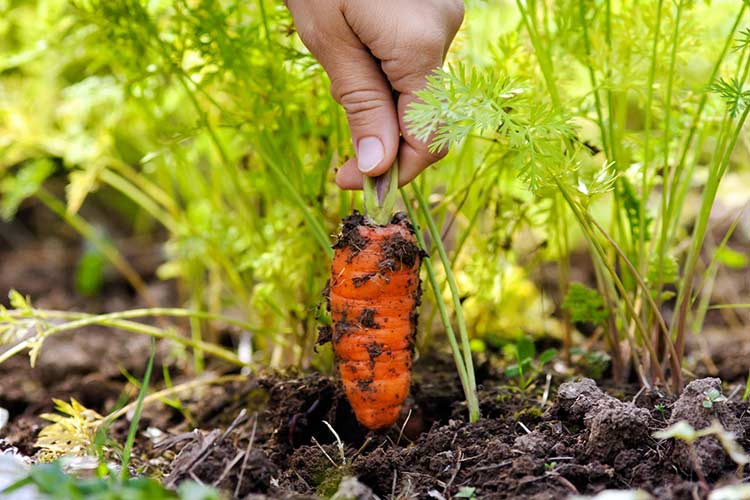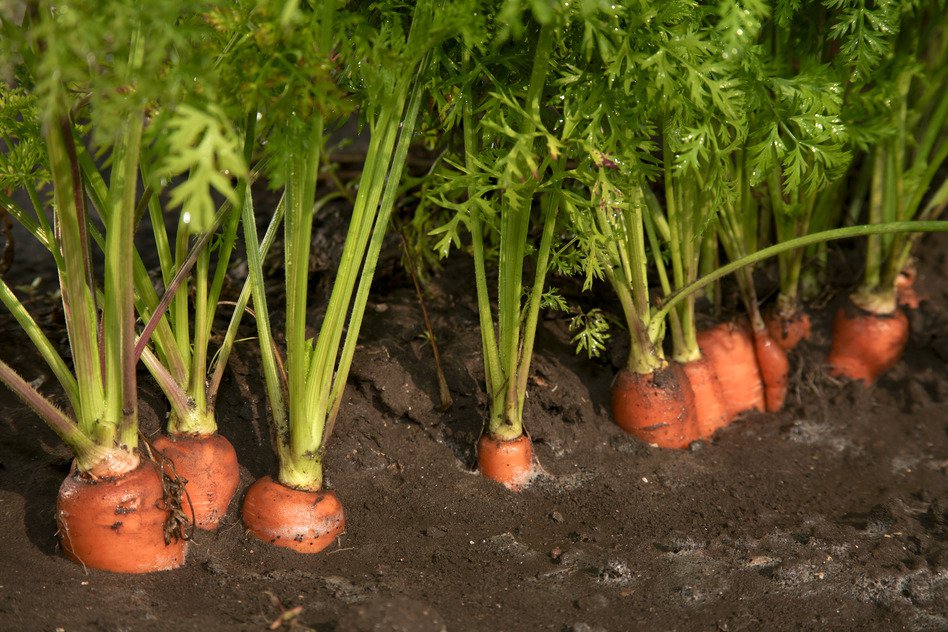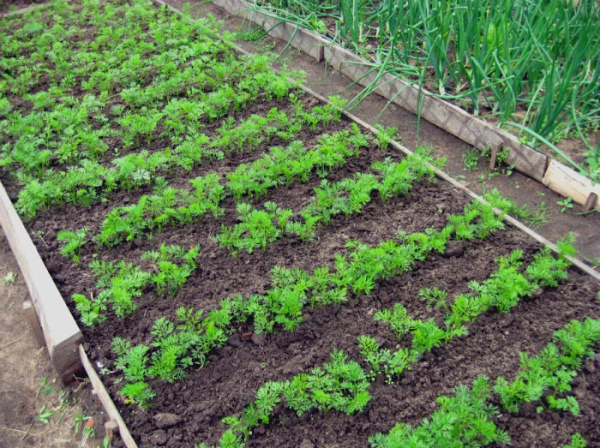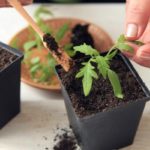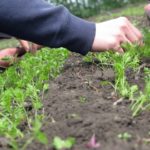Carrots are one of the most unpretentious crops, gratefully responding with a good harvest to a minimum of effort even for a novice gardener. However, information on how to water carrots in open ground should be studied by the owner of the plot before the seeds are planted in the ground. This is necessary to ensure that all efforts made to obtain a good harvest are not in vain due to failure to comply with the simplest conditions for proper watering.
Pre-watering before planting
With the right approach to growing carrots, the first watering is carried out six months before planting the seeds - that is, in the fall, after digging and fertilizing the soil “in winter.” Such thorough cultivation of the soil does not free the gardener from completely repeating the entire process when the soil warms up and it is possible to begin planting. Moistening the soil before sowing with warm water is a prerequisite for carrot seeds in open ground, planted 1-1 ½ cm deep, to remain in the ground and not float to the surface with the flow of water.
The first watering of carrots, that is, the soil for planting, must end with the obligatory preservation of the moisture introduced into the soil and, at the same time, protecting future plants from night frosts. The open ground, after planting the seeds in a convenient way (on a tape or by piece sowing), is covered with plastic film, which is not removed until the next watering.
From the very first steps of the simple science of gardening, learn an important rule that applies to all garden crops without exception - never water with water from a hose attached directly to the tap. Low temperatures are poorly perceived by plants, regardless of the varietal of the future vegetable, and cold tap water, in addition, also contains heavy impurities that settle in the soil.
Irrigation rates
How often to water carrots after planting? At the stage when all the strength of the seed goes into releasing the root system, the future carrot must be kept in constant dampness, but without much zeal. The settled water, in an amount so that it does not stand in the recess of the row, can be dispersed from an ordinary watering can, and the procedure itself should occur at least once every five days.2-3 hours after watering, the bed should be carefully fluffed up, avoiding the formation of a hard crust.
Once the tops are formed in the amount of 2-4 sprouts released, the plant is watered less frequently, but still the amount of watering should correspond to constant light soil moisture - this is at least 4 times a month. During the development of carrot tops and the degree of ripening of the root crop, the amount of moisture will vary.
How often should you water carrots in open ground? There is no specific pattern for these variations, since the level of aridity and precipitation in each region is different, but approximate norms may look like this:
- When the first shoots appear (May), the norm is set at 5 to 6 liters of water per 1 m2. How often carrots need to be watered is decided based on weather conditions, but the average per month is 7 times;
- At the next stage, which falls in June, the number of irrigations is reduced to four, and the volume of liquid reaches 12 liters per 1 m2;
- In August, water the beds no more than twice a month, using water according to the original volume - within 6 liters per 1 m2.
They stop moistening the soil approximately three weeks before harvesting and at the same time apply the last fertilizing in the form of salt or nitrate.
Automatic watering method
Sprinkling systems - automatically supplying beds with the required amount of water with its uniform distribution over the soil - are now experiencing a boom in popularity. Moisture does not fall to the ground under direct pressure, which inevitably entails erosion of the open soil and its glossing under a dense crust, but after the stream is crushed into small drops.
Such proper watering does not require repeated loosening of the soil - the soil will remain loose and saturated with oxygen.
The intensity of automatic watering can be adjusted in such a way that the mass of moisture falling on the soil does not stagnate on the rows and between them, but completely penetrates into the ground. This is the only disadvantage of the method - sprinkling occurs all the time under a constantly set flow and adjustment will have to be done manually.
Liquid feeding of root crops
The pipping of the first green shoot from the soil serves as a signal to stop fertilizing applied to the soil. Until the tops form into a small panicle, any additional microelement introduced along with watering can burn the young plant and interrupt the growth of the vegetable. Only the formation of 2-4 full-fledged branches allows the use of a low concentration nutrient composition dissolved in water.
How to properly water carrots with diluted feeding concentrates? If you prefer to use organic matter, then water the beds with a solution containing chicken manure, prepared in this way: pour the organic matter with cold water 1:5, put it in a cool place for 7 days, and then the resulting grounds, again using cold water, are diluted 1:10.
At the moment when you water the beds with carrots with this composition, make sure that the liquid does not get on the plants themselves. It is best to water strictly between rows.
Fertilizing with diluted cow manure is organized in the same way, however, for the development of good strong rhizomes, chicken manure is preferable.
Mineral fertilizers - potassium sulfate with urea, are applied to the soil 3 weeks after organic feeding. For 2 teaspoons of sulfate diluted in 10 liters of water, take less than 1 teaspoon.a spoonful of urea, which is also diluted in a small volume of liquid.
When calculating proportions, try not to flood your carrot garden with high concentrations of fertilizers - this greatly reduces the subsequent storage life of the vegetable. Carrots, when sulfate fertilizer accumulates, quickly begin to rot.
Aqueous saline solution
Fertilizing with simple table salt will help make the root vegetable sweeter and juicier. The only drawback of this solution is that even if you are not a fan of using organic matter in the garden, next planting year you will have to use it in any case to saturate the soil, which is somewhat deprived of salt water.
To dilute the salt concentrate, take 2 teaspoons of coarse salt (not iodized) and dissolve until all crystals completely disappear in 10 liters of water. Water only pre-moistened soil with this solution, ideally after a good rainfall, when the soil is saturated with soft rainwater.
A similar result, in order to make carrots delight with sweetness, is obtained by diluting saltpeter or wood ash.
The saline solution will help get rid of two more misfortunes that await you while caring for growing carrots - mold and slugs, which readily devour root vegetables. Both factors are formed due to excess moisture in the soil, which does not always depend on irrigation, but is most often the result of heavy rains.
Is it necessary to water carrots at all, if the vegetable will already be immersed in water? A few liters of salted water will no longer play a big role in terms of humidity levels, but the low degree of disinfection from pests and fungi, carrots definitely won't hurt. In total, it is recommended to do 4 “salty” waterings per season.
Secrets of proper watering from experienced gardeners
It happens that even planting done according to all the rules and most carefully followed care recommendations do not save you from disappointment at the time of harvest. Vegetables come to the surface pale, gnarled and branched into many unnecessary shoots. What is the matter and is it worth stopping your gardening experiments here?
This result is, as a rule, the error of improper soil moisture, or rather, weak penetration of moisture to the entire required depth of root crop formation. The roots, which determine the level of moisture, are thin white hairs that sensitively detect any changes in the saturation of the soil with water.
Starting to dry out, they stop growing downwards and begin to look for options in which they can get water in other directions. This is where we get strange rhizomes with outstretched arms and legs, unsuitable for cooking.
Correction of the error is possible no later than a month before digging up the crop. Between the rows you should dig grooves 10-12 cm deep, then the garden needs to be watered, but the emphasis should be on filling these grooves to the top - this will make it easier for moisture to penetrate to the required depth.
Make it a habit to collect rainwater and use it for irrigation. If only tap water is available, it must be left in a container for at least three days. Well water is enough for one day, but only if during this time it has time to warm up well to 18-210.
It is not without reason that the minimum number of necessary waterings was mentioned several times in the article, but performing the entire quantitative number of procedures is not as important as correctly organizing the regularity with which they will be performed.Root crops will not crack and will not lose their taste if instead of 8 waterings (of course, with warm, not ice water), you do 6, but “lame” pause times can completely ruin the harvest and make any efforts in vain.

